Since Google’s driverless car was awarded a license plate on the road last year, people’s hot discussion about the plan has not stopped. Insiders said that for the goal of achieving unmanned driving, the time node industry is defined as 2025! Whether the target can be achieved on schedule is not easy to say, but the advanced driver assistance system ADAS technology related to this has been more Well known. ADAS refers to the use of various sensors and cameras installed in the car to collect environmental data inside and outside the vehicle at the first time, and perform technical processing such as identification and detection of static and dynamic objects, so that driving can be performed. The fastest time to detect the dangers that may occur.
This article refers to the address: http://
Whether it's Google's radically direct development of driverless cars, or traditional carmakers incrementally and incrementally making car driving smarter, their goal is to help reduce traffic accidents, reduce time and energy wasted. Indeed, there are data showing that in all types of road traffic accidents, human error accounts for 77% to 90%.
With the advancement of national governments and public safety awareness and related regulatory standards, various ADAS applications and sensing platforms have also been infiltrated from high-end cars to mid-range and even entry-level car models. According to IHS isuppli's automotive research report, the total revenue of the three ADAS technologies, including Adaptive Cruise Control System (ACC), Lane Departure Warning (LDW) and Side Object Detection (SOD), will reach US$2.69 billion, an increase. Up to 63%.
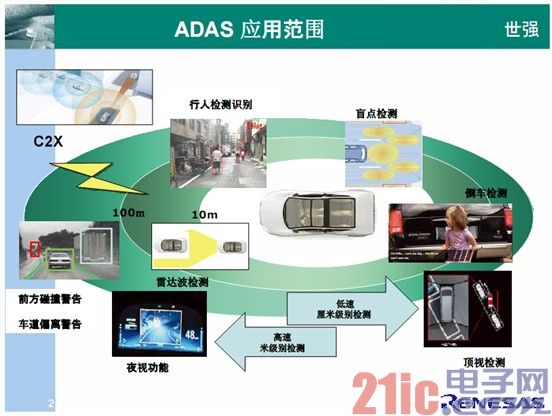
Figure 1: Application of ADAS in driving warning/assistance.
"ADAS technology has become a hot spot for intelligent transportation in recent years, and naturally it has also attracted close attention and follow-up by Chinese automakers," said Tony Hu, senior marketing manager at Shiqiang. "Especially for lane correction, including LDW and lane keeping assist systems ( LKAS), as many countries require LDW as a function of ADAS for trucks, buses, etc., the European car regulations will require the bus to be equipped with a lane offset system in 2013, and the United States is included in the 2014 regulations. It is also expected to be introduced in 2016. As a result, the demand for lane correction is on the rise, and this feature has become standard in high-end cars and SUVs as well as some mid-range cars."
As one of the world's largest auto electronics semiconductor suppliers, Renesas (Renesas), Shiqiang has partnered with third-party partners to launch an advanced automotive surround vision assisted driving system solution based on Renesas' latest image processor SH7766. Received a lot of customer attention. “Customers have a high evaluation of this program. Compared with competitive product solutions, Renesas is taking a 'high but not expensive' route. The outstanding advantage of its products is that the image processing capability is realized by a hard core engine, and the processing speed is faster than the DSP mode ( Software algorithms) will be faster and performance will improve significantly," Tony pointed out.
Image processing advantage is the key to the success of driving warning/assisted ADAS
ADAS applications are generally divided into two levels: one is a visual aid system, including the reverse development function; the second is a driving warning/assist system that covers the lane offset system. For the former, the visual aid system image processor only needs to have image correction and display functions, and for the driving warning/assist system, it is necessary to perform image recognition, which is technically more difficult.
For mid- to high-end driving warning/assisted ADAS systems, the value of display applications is increasingly prominent, helping drivers to monitor the surrounding environment of vehicles when parking, especially for rear-view monitors and overhead systems. In addition, image recognition systems It also tends to be diversified. In addition to the lane recognition function, it also includes the simultaneous identification of multiple objects, such as lights and signs, pedestrians and cars. Therefore, the requirements for image recognition engines are becoming higher and higher, and multiple processes must be performed simultaneously. operation. If you want to deal with different identification algorithms to identify objects with different shapes and directions, such as pedestrians, you need to adopt an effective architecture combining CPU and professional IP.
Tony analyzed that although several leading international semiconductor manufacturers are promoting the corresponding image processing chip solutions, Renesas, which has been deeply involved in the automotive electronics field for many years, has its unique advantages, especially in terms of image processing performance and real-time performance. For example, Shiqiang is helping the image recognition SoC SH7766, which is being promoted in the Chinese market. It integrates a hardware engine that supports new view functions such as viewpoint conversion engine and dynamic range control. It is more advantageous than DSP and software algorithm.
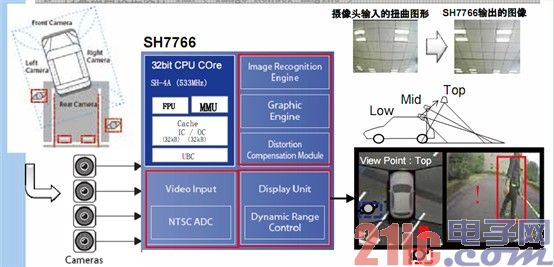
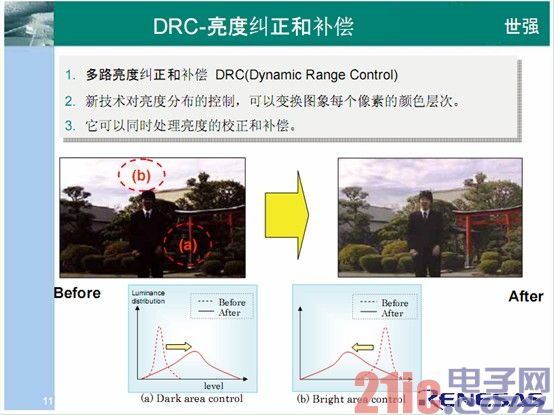
Figure 2: Support for 4-way camera, high-performance image recognition engine integration DRC and IMR are the highlight features of the SH7766.
The SH7766 SoC maintains compatibility with Renesas' previous generation image recognition SoC, the SH77650, while providing enhanced performance, enhanced viewpoint capabilities, and improved image recognition engine performance. In particular, display functions such as viewpoint conversion and dynamic range control (brightness compensation, etc.) are enhanced. These new features enable more applications for this product, such as clear and easy-to-view top-view virtual camera visualization, real-time display of changing surrounding environments with different viewpoints for ADAS monitoring of surround and perimeter detection .
Specifically, the SH7766's following advantages in image processing are particularly compelling:
1. Peripheral object detection (support 4 camera)
The SH7766 SoC is equipped with six video input channels. Among them, four channels use NTSC analog-to-digital converter (ADC). This means that the necessary functions of the NTSC camera system can be provided on a single chip. In addition, multiple video input channels can be used to implement multiple applications, using the features offered on a single chip. For example, digital dual-channel input can be used during normal driving, and NTSC four-channel input can be switched at intersection and parking.
2. High performance image recognition engine
The SH7766 SoC is equipped with the IMP-X2 next-generation image recognition engine. The IMP-X2 maintains database compatibility with Renesas' existing image processing engine (IMP) while increasing processing performance by more than four times, enabling it to perform multiple processing tasks in parallel, such as tracking lanes, signs and Marking lines, pedestrians and vehicles. In addition, it has added a number of functions, such as panoramic image generation, which uses an image recognition algorithm that is judged by pedestrians, vehicles, etc. Through the cooperation between the IMP-X2 and the CPU on the same chip for processing, advanced image recognition performance is achieved while maintaining low power consumption.
3. Integrated DRC, support brightness correction and compensation
Relying on the dynamic range control (DRC, Dynamic Range Control) function, even when dealing with multiple video images with different brightness at the sun and the shade, the composite video brightness can be adjusted to compensate for over-brightness and over-brightness for the driver. See the image display more clearly.
4. Built-in distortion correction hardware IMR
The Image Renderer (IMR, Image Render Engine) viewpoint conversion engine can generate a viewfinder image that is different depending on the video input or scene. The triangle mesh is used to correct the distortion mode, and the vertex data in the rectangular mesh is automatically generated. Perform distortion correction, rotation, reduction or enlargement.
Shiqiang's first push for advanced car vision assisted driving system
Based on SH7766, Shiqiang and the third-party design company have developed a set of advanced car vision assisted driving system solutions (as shown in Figure 3), which is the first in the distribution industry! This set of looking ADAS system solutions has powerful image processing capabilities. Achieve ultra-clear images and high-quality color reproduction; perfect picture brightness and darkness, from automatic adjustment of high dynamic range; and only very low CPU occupancy and power consumption. This solution can be applied to automotive safety systems such as lane departure warning systems (LDW), lane keeping assist systems (LKAS) and other typical ADAS applications.

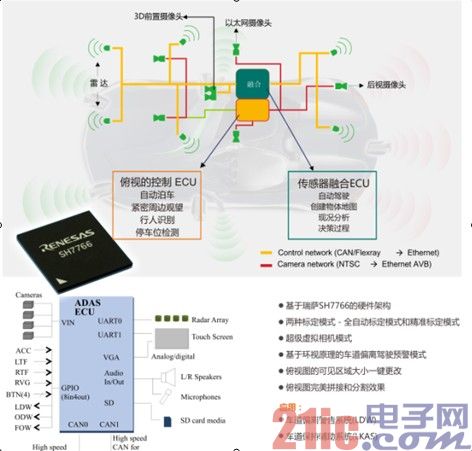
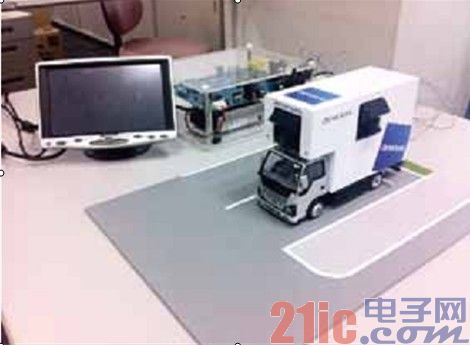
Figure 3: Block diagram and demo of the advanced car surround assisted driving system program launched by Shiqiang and the third party.
According to Tony, the vision-based ADAS system solution offers two calibration modes - fully automatic calibration mode and precision calibration mode:
1. The fully automatic calibration mode is powerful and reliable, and does not require the demanding requirements of the camera installation angle; it is suitable for mass production;
2. Semi-automatic precision calibration tools can be used to provide the best calibration results in poor lighting conditions or harsh environmental conditions. In addition, the system solution supports super virtual camera mode, can generate virtual view at any viewing angle, and can use virtual camera parameters, focus, generated view, fisheye and pinhole camera.
Other features of Shiqiang’s vision of the ADAS program include:
1. Supporting the lane departure driving warning mode based on the look-around principle: the lane-based lane departure technology opens up new areas and expands the application of the surround driving assistance system;
2. The size of the visible area of ​​the top view is changed by one button;
3. The top view is perfectly stitched and split;
Alternatives to a variety of modules (including: 3D effects of the viewing interface; DVR; 3G-based video viewing and information management; voice reversing guides, etc.).
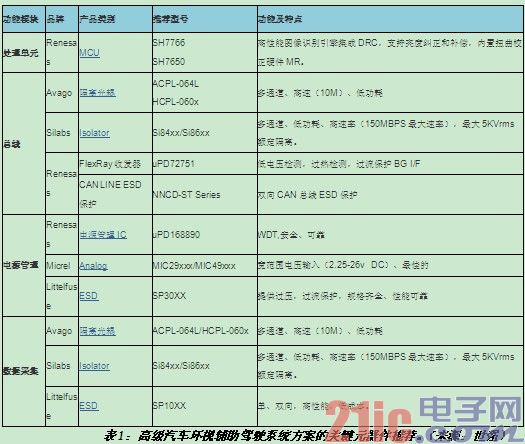
Pm Stepper Motor,Square Flange Stepper Motor,High Precision Stepper Motor,Permanent Magnet Stepper Motor
Changzhou Sherry International Trading Co., Ltd. , https://www.sherry-motor.com